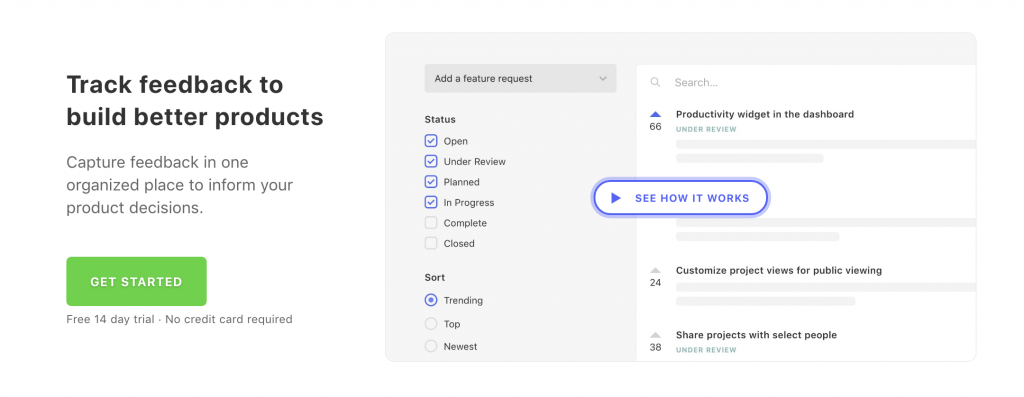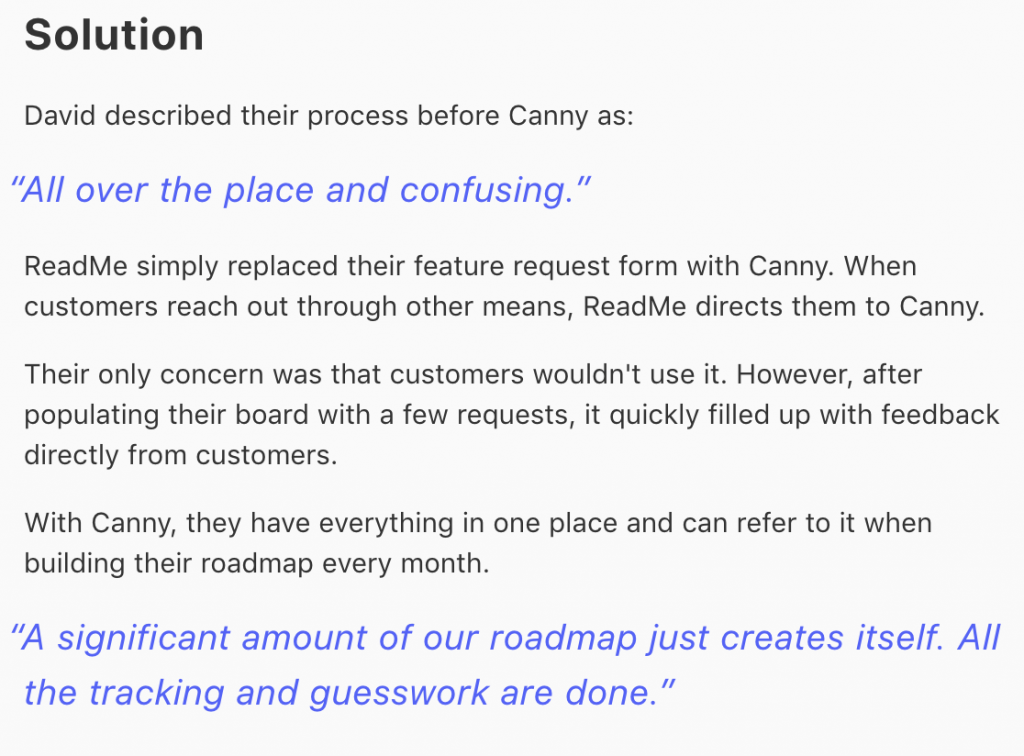So, you’ve built a software product. Well done! You think your product value is through the roof. It’s useful, functional, beautiful, valuable, and overall absolutely amazing. There’s a problem though.
The problem is that you think these things because you built it. To make your business succeed (and, let’s be honest—survive), you have to convince others of these things.
Potential customers don’t immediately see your product as the best solution out there. They see it as a solution, usually among many others.
In the saturated software market we’re dealing with, very few products are truly unique. You’re one in ten. Or a hundred. Or a thousand. Why should you be the top choice?
Let’s be real—nobody out there is dying to use your product just because it’s there.

Sorry!
Fret not though—there’s a way to make sure you’re at least one of the top choices.
People and businesses use SaaS products for one thing only—their own benefit. Whether it saves them time or makes them money, the only thing people choosing a software care about is the value it adds to them.
Depending on your business, there can be many value elements:

This value is never obvious to anyone but yourself. This means you have to be smart with communicating it. You have to put the value your product offers front and center in every external bit of communication.
If you manage to prove the value well, you have to worry less about the price tag, too.
Here’s how to clearly present the value of your product to your potential customers.
Figure out what value means to your target group
You can’t communicate anything unless you know what it is you’re trying to put out there.
Every product has a target group (or even a few)—the people or companies the solution is made for. This target group should be the only thing you think of. Leave yourself and what you think the value is out of it.
To define the value of your product, you need to understand the challenges your target group(s) face. This is a very practical exercise that involves the following steps:
1. Write down who your target group(s) are and the people they involve
- If your target group is individuals, you’re good on the “people” aspect—just write down a description of the person who buys your product.
- If you’re selling software to companies, write down the persona(s) within the company who would be making the purchase decision.
For example, at Canny, our main target group is SMB-s (small and medium-sized businesses).
Within these businesses, the people who would be looking for a solution like ours are:
- Product managers
- Customer-facing roles (customer support, customer success…)
2. Figure out what the goals and challenges are for these targets
…based on:
- Your own experience (if you have any—be honest with yourself if you don’t)
- Research in relevant circles
- Public discussions
- Asking your existing customers (and anybody else that matches your defined personas)
For example, let’s take “product managers” for Canny:
Their goal: building a product that offers value to their customers
Their challenges with this goal:
- Feedback getting lost in cracks because of too many channels
- Wasting time on building useless features
- Not being able to prioritize clearly
3. Figure out how your product fits into it
Now, write down how your solution helps your targets get rid of these challenges or get closer to their goals.
For example, for our Canny target group issues:
- Feedback getting lost—Canny directs all channels to one place
- Wasting time on building features nobody will use—clear overview of which features are most wanted and needed in the customer base
- Not being able to prioritize—segmentation of most crucial customers and their requests
And there you go—you have your official value points!
Keep in mind that this is a very generalized process to get you started. Feel free to go as in depth into this as you want.
The important thing is that before communicating anything to the outside, you need to make it clear to yourself what your value is. And again—this value needs to be based on what your customers need, not what you think they need.
If your product doesn’t help with these challenges your target group has… well, you need to either pick a different target market, or rethink your product—sorry!
Highlight your main value first in all your materials
Now that you’ve figured out your value points, you can start including them to all of your external communication.
This means:
- Your website and other online properties
- Your sales pitches
- Your marketing campaigns
- Your support communications
- Your product itself
To make it easier to put your main value front and center, figure out the short version of it.
This is usually one sentence or phrase, a “slogan” if you will, that summarizes the main benefit of your product.
For Canny, this is “build better products”. Here it is as the first thing you see on our website:

More examples, you say?
Here’s one of our favorite companies, Ahrefs, with “grow your search traffic”:

Here’s Bench, another awesome company, with “don’t spend your valuable time staring at spreadsheets”:

… you get the gist. Make sure the benefit for the customer is the first thing they see when they look at your… well, anything.
Lead with this main thought in every conversation about value you have. Supplement it with the more detailed value points that go under it.
Benefits before features
Your product has features. Well done. Every product does. However, features describe functionality.
Describing functionality isn’t information that is going to sell your product. Remember—when people are looking for a solution, they’re thinking about the challenges they have.
For example, “Canny helps you collect feedback”.
…

“I already “collect feedback”. Why do I need a tool for it?”
Seeing a random feature doesn’t translate into “this solves a problem for me” for anyone.
This is why you also have to explain what the benefits of your features are. Try to follow up with a relatable value example for every feature you have, or plan to have.
Here’s another Canny example:
“We have a changelog feature where you can announce product updates.”
… vs:
“We have a changelog feature, where you can announce product updates to engage people with your newest features.”
The first example provokes no value feelings. The second one clearly states what the benefit is for the person using the changelog. Obviously, we went with…

Getting people to engage with new features is a benefit that our target group wants.
Always focus on benefits, not features. We’re all selfish here. Features aren’t exciting. Benefits are.
Always segment your audience when talking about value
This comes back to the target groups you defined in the first step.
If you only have one target group, it’s a little easier for you. If you have several, you’ll want to adjust your messaging depending on who you’re talking to.
Remember—you’re not the only solution out there. Someone is giving you the time of day to explore your product as an option. You need to capture their attention immediately by describing the value to them.
Here are some ways to make sure you don’t generalize your messaging:
Write content that highlights specific use cases for your target groups
For example, we have a “Canny best practices” series that is easy to find for people looking for a solution for their use case specifically.
Build targeted landing pages for your different target groups
These will come up when someone searches for a specific use case that your product offers, and spares them the time of going through functionality they don’t need.
If you offer demos (or someone requests one), do your homework
Learn about the company (or customer) and what they do, who the person is you’re going to be talking to, and what their challenges are.
You can even go as far as shooting over a few questions before your chat to ask them straight out.
Personalization is never a bad thing when it comes to selling software. You’re already doing a good job of focusing on value. Now take it a step further and segment that value for different users.
Use case studies and examples of other customers
Case studies are a great way to have someone else toot your value horn.
Firstly, recommendations are always more reliable if they come from someone else rather than the company itself.
Secondly, case studies are a great way for potential customers to relate to others using the product and liking it.
When putting together case studies:
- Again, focus on value first—it doesn’t help when someone just says “yeah this product is good”. Ask your case study buddy to explain how your product adds value to them.
- Keep it humble. Yes, case studies are meant to praise your product, but keep it on the DL with the horn tooting. Focus on actionable and useful information.
For example, Canny’s case studies consist of three parts—challenge, solution, and results.
Here’s what that looks like in the case study for ReadMe, one of our customers:
Challenge:

Solution:

Results:

The challenge is what your target group can relate to. The solution is how Canny fits into that challenge. The results show the clear benefits the team has seen from using the product.
It’s a simple principle of social proof—“If another company like mine is getting value from this product, so can I”.
Use it well.
Focus on what your potential customers need
Yes, your main objective is to sell your product and make money. It’s how every business works. We don’t have to deny it.
However, in order to get money, the people giving you money need to get something that’s worth paying money for.
You’re not selling your product, you’re selling what people gain from it—whether it’s time, money, or something else.
Figure out what these worthwhile things are for your target audience. Communicate it to them, clearly and strongly. You’ll already put yourself one step ahead of your competition.
You’ll also be much more aware of the challenges your customers face, and will be able to improve your product based on it.







This is our main problem actually now. We have a software product and we have problems to reach the customers. This article is so useful. Thanks a lot!